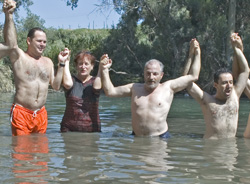Saving the Jordan
Sixty years ago, it carried 45 billion cubic feet of fresh water and powered a hydroelectric plant. Today, only 3.5 billion cubic feet flow down the lower Jordan River—and of this, about half is sewage or salt water. Some stretches are so dry, you’d have to portage a kayak. While deterioration on this scale is appalling anywhere, it’s especially so when the body of water in question has such deep resonance in human culture.

“Half of humanity sees this river as holy!” says Gidon Bromberg, Israeli head of the tri-national Friends of the Earth Middle East (FoEME). The nonprofit is that rarest of Middle Eastern birds: a group of Palestinians, Jordanians and Israelis who work together on shared concerns. In separate phone interviews, both Nader Khateeb and Munqeth Mehyar, the Palestinian and Jordanian heads of the organization respectively, say they’re mindful that many believe they should have no contact with Israelis (at least until the occupation of Palestinian lands is resolved). But the river’s plight can’t wait.
“Nobody denies the priority of solving the conflict,” Khateeb says. “But by the time the politicians are done, the environmental degradation will be so [advanced], this land that we’ve been fighting over for decades will not be suitable for living anymore.”
Mehyar sounds a similar note. “The ecosystem is so small that any action, by any party, affects the others,” he says. “You can’t say that you won’t talk to the other side—you’re only hurting yourself.”
The lower Jordan meanders for 125 miles between the Sea of Galilee in the north and the Dead Sea in the south. It forms the eastern edge of both Israel and lands recognized internationally as part of a future Palestinian state. It is the western edge of the Kingdom of Jordan.
Both the Hebrew Torah and Christian Bible are filled with references to the lower Jordan region, where Moses” body was laid out and John the Baptist preached. American Christian and Jewish scriptures are also holy to Islam, the faith of some 85 percent of Palestinians and nearly 100 percent of Jordanians.
Today, Bromberg says, making pilgrimage to the traditional site of the baptism of Jesus “is a health hazard. You’re likely to come out with a rash on your head.”
Running along the lowest spot on Earth, the waters of the lower Jordan gather at the ecological intersection of Asia, Africa and Europe. A wide variety of flora and fauna, including the Palestinian Mountain Gazelle and the Yellow Flag Iris, find their northern and southern limits in the valley, and everyone from early humans leaving Africa to modern armies have passed through. Farmers first cultivated wheat near Jericho, a small city better known for its appearance in the biblical book of Joshua. In the 1990s, Jericho became the first part of the West Bank to be handed over to Palestinian rule by the occupying authorities.
The river’s steep decline has been exacerbated by the continuing Palestinian-Israeli conflict. Israel diverts some 60 percent of the fresh water heading downriver from the Sea of Galilee. Jordan maintains a major canal that diverts water from the Yarmuk River, the Jordan River’s largest single tributary. Syria has built more than 60 dams upstream on the Yarmuk. Israeli municipalities and kibbutzim illegally release untreated sewage. And on both banks, most of the river basin is a closed military zone, its failing state hidden from view by Israel’s and Jordan’s military blockades.
In an effort to better inform both the local and international communities, FoEME recently attempted a unique event: an exploratory journey down the length of the lower Jordan, but were limited in their travels by the Israeli military.
The expedition, held from November 26 to 29, marked the anniversary of a similar trip, made in 1848 by American Naval Officer William Lynch. One of many exploratory missions sponsored by the U.S. Navy at the time, Lynch’s expedition gathered data that is still used by the scientific community. Over the coming months, FoEME will be comparing its findings to his.
Mehyar, Khateeb and Bromberg all express a heartfelt passion for the river, and deep frustration over its demise. “We are losing it,” Khateeb says. “It’s not important only for us; it’s very important for the whole world.”
With an eye on projects planned in Israel, Jordan and Syria for further diversion of the river’s little remaining fresh water, Mehyar says that if nothing changes, “in a couple of years
there will be no more water going down the Jordan, except from occasional springs and agricultural run off. The river bed will have absolutely no water.”
Ultimately, FoEME hopes that its scientific research will capture the attention not only of the region’s communities and governments, but also the United Nations Scientific and Cultural Organization (UNESCO). The idea, they say, is to restore the river, providing limited access to restricted sections and developing sustainable management plans. At a minimum, Bromberg says, the Jordan should have 10 billion cubic feet of fresh water flowing between its hallowed banks. “Without it,” he says, “the river will no longer live.”
As with all things in this part of the world, much depends on politics. The 2006 war between Israel and Hezbollah could yet lead to Israeli rapprochement with Syria and open the door to regional environmental talks; on the other hand, a single Palestinian attack or Israeli raid could reverse any small advances FoEME makes.
While they acknowledge this uncertainty, the leaders of FoEME maintain some optimism. “Conflict actually increases our strength,” Mehyar says, “because we can see the foolishness of it.” Khateeb provides the most straightforward explanation: “In our area,” he says “you cannot give up, because if you give up, you’re finished. We need to save something for our children, so that they will have a better life.”

